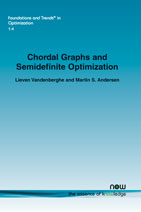Chordal Graphs and Semidefinite Optimization
By Lieven Vandenberghe, University of California, Los Angeles, USA, vandenbe@ucla.edu | Martin S. Andersen, Technical University of Denmark, Denmark, mskan@dtu.dk
Abstract
Chordal graphs play a central role in techniques for exploiting sparsity in large semidefinite optimization problems and in related convex optimization problems involving sparse positive semidefinite matrices. Chordal graph properties are also fundamental to several classical results in combinatorial optimization, linear algebra, statistics, signal processing, machine learning, and nonlinear optimization. This survey covers the theory and applications of chordal graphs, with an emphasis on algorithms developed in the literature on sparse Cholesky factorization. These algorithms are formulated as recursions on elimination trees, supernodal elimination trees, or clique trees associated with the graph. The best known example is the multifrontal Cholesky factorization algorithm, but similar algorithms can be formulated for a variety of related problems, including the computation of the partial inverse of a sparse positive definite matrix, positive semidefinite and Euclidean distance matrix completion problems, and the evaluation of gradients and Hessians of logarithmic barriers for cones of sparse positive semidefinite matrices and their dual cones. The purpose of the survey is to show how these techniques can be applied in algorithms for sparse semidefinite optimization, and to point out the connections with related topics outside semidefinite optimization, such as probabilistic networks, matrix completion problems, and partial separability in nonlinear optimization.
Chordal Graphs and Semidefinite Optimization
Chordal graphs play a central role in techniques for exploiting sparsity in large semidefinite optimization problems, and in related convex optimization problems involving sparse positive semidefinite matrices. Chordal graph properties are also fundamental to several classical results in combinatorial optimization, linear algebra, statistics, signal processing, machine learning, and nonlinear optimization.
Chordal Graphs and Semidefinite Optimization covers the theory and applications of chordal graphs, with an emphasis on algorithms developed in the literature on sparse Cholesky factorization. These algorithms are formulated as recursions on elimination trees, supernodal elimination trees, or clique trees associated with the graph. The best known example is the multifrontal Cholesky factorization algorithm but similar algorithms can be formulated for a variety of related problems, such as the computation of the partial inverse of a sparse positive definite matrix, positive semidefinite and Euclidean distance matrix completion problems, and the evaluation of gradients and Hessians of logarithmic barriers for cones of sparse positive semidefinite matrices and their dual cones. This monograph shows how these techniques can be applied in algorithms for sparse semidefinite optimization. It also points out the connections with related topics outside semidefinite optimization, such as probabilistic networks, matrix completion problems, and partial separability in nonlinear optimization.
